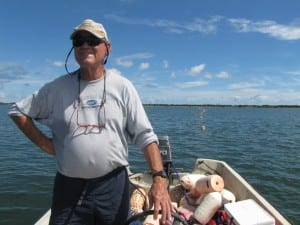Climate Change Threatens 30 Years of Conservation
 A new University of Central Florida study is sounding the alarm about climate change and its potential impact on more than 30 years of conservation efforts to keep sea turtles around for the next generation.
A new University of Central Florida study is sounding the alarm about climate change and its potential impact on more than 30 years of conservation efforts to keep sea turtles around for the next generation.
Climate change is causing sea-level rise, and how coastal communities react to that rise could have dire consequences for sea turtles and other wildlife that rely on an unobstructed beach for survival. That’s the conclusion of a University of Central Florida study recently published in Chelonian Conservation and Biology.
Llewellyn Ehrhart, a biology professor emeritus at UCF, began studying sea turtles in what later became the Archie Carr National Wildlife Refuge in southern Brevard County 31 years ago. By documenting the number of turtles laying eggs, the number of eggs that hatch and how many turtles make it to the water, he was able to demonstrate what is documented fact today: The 13-mile stretch of beach in southern Brevard is one of the most important nesting habitats for green and loggerhead turtles in the western hemisphere.
Ehrhart and his team took the turtle data and looked at how sea level has risen over the same timeframe.
“The crux of the matter is that sea-level rise is happening, there’s no question,” Ehrhart said. “Our response has to be an intelligent one. We can’t continue to build hard structures because it is only going to make matters worse for sea turtles and the beach in general. We need courageous leadership to find good solutions, not just easy ones.”
 Sea-level rise and an increase in storm intensity could potentially impact the refuge in two fundamental ways. The first includes beach erosion and an overall narrowing of the beach berm within refuge boundaries. Currently, egg and nest loss to erosion is the factor that has the greatest negative impact on the emerging success of hatchlings. The team suggests that the way communities respond to the eroding beaches is hurting wildlife and could have disastrous effects on the sea turtles, which have had an almost miraculous recovery at the refuge since the 1970s.
Sea-level rise and an increase in storm intensity could potentially impact the refuge in two fundamental ways. The first includes beach erosion and an overall narrowing of the beach berm within refuge boundaries. Currently, egg and nest loss to erosion is the factor that has the greatest negative impact on the emerging success of hatchlings. The team suggests that the way communities respond to the eroding beaches is hurting wildlife and could have disastrous effects on the sea turtles, which have had an almost miraculous recovery at the refuge since the 1970s.
Sea turtles have seen a dramatic rise in numbers after the refuge was created in 1991, giving turtles a protected place to lay their eggs. Green turtles numbered in the 30s in 1982, Ehrhart said, recalling his early days in the field. This past year there were more than 12,000. The comeback was also seen in loggerhead nests, which numbered 9,000 in the 1980s and had more than 15,000 in 2014.
His study found that armoring (putting up hard surfaces to protect against erosion) has a negative impact on beaches. It puts up barriers to wildlife and impacts sea turtles’ ability to nest. These barriers can also have a negative impact on other wildlife.
“It’s not a popular idea, but we need to allow beaches to move,” he said.
The study suggests a plan of action needs be put in place to guard against the pending effects of climate change. Given that the sea level has risen about 5.75 inches in 112 years, and continues to rise at a more rapid pace, the erosion of beaches will also continue more rapidly, the study says.
Armoring the private and commercial properties in the refuge would be disastrous for the habitat, Ehrhart said. A strategic plan could help prevent this and tackle the problem of naturally occurring erosion issues as well, he said.
The authors of the study include: Ehrhart, William Redfoot, Dean Bagley and Katherine Mansfield from the University of Central Florida.
To view the original article, visit UCF Today.
